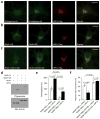Palmitoylation of huntingtin by HIP14 is essential for its trafficking and function
- PMID: 16699508
- PMCID: PMC2279235
- DOI: 10.1038/nn1702
Palmitoylation of huntingtin by HIP14 is essential for its trafficking and function
Abstract
Post-translational modification by the lipid palmitate is crucial for the correct targeting and function of many proteins. Here we show that huntingtin (htt) is normally palmitoylated at cysteine 214, which is essential for its trafficking and function. The palmitoylation and distribution of htt are regulated by the palmitoyl transferase huntingtin interacting protein 14 (HIP14). Expansion of the polyglutamine tract of htt, which causes Huntington disease, results in reduced interaction between mutant htt and HIP14 and consequently in a marked reduction in palmitoylation. Mutation of the palmitoylation site of htt, making it palmitoylation resistant, accelerates inclusion formation and increases neuronal toxicity. Downregulation of HIP14 in mouse neurons expressing wild-type and mutant htt increases inclusion formation, whereas overexpression of HIP14 substantially reduces inclusions. These results suggest that the expansion of the polyglutamine tract in htt results in decreased palmitoylation, which contributes to the formation of inclusion bodies and enhanced neuronal toxicity.
Figures







Similar articles
-
Huntingtin-interacting protein HIP14 is a palmitoyl transferase involved in palmitoylation and trafficking of multiple neuronal proteins.Neuron. 2004 Dec 16;44(6):977-86. doi: 10.1016/j.neuron.2004.11.027. Neuron. 2004. PMID: 15603740
-
HIP14, a novel ankyrin domain-containing protein, links huntingtin to intracellular trafficking and endocytosis.Hum Mol Genet. 2002 Nov 1;11(23):2815-28. doi: 10.1093/hmg/11.23.2815. Hum Mol Genet. 2002. PMID: 12393793
-
Rescue of aberrant huntingtin palmitoylation ameliorates mutant huntingtin-induced toxicity.Neurobiol Dis. 2021 Oct;158:105479. doi: 10.1016/j.nbd.2021.105479. Epub 2021 Aug 12. Neurobiol Dis. 2021. PMID: 34390831
-
Aberrant palmitoylation in Huntington disease.Biochem Soc Trans. 2015 Apr;43(2):205-10. doi: 10.1042/BST20140242. Biochem Soc Trans. 2015. PMID: 25849918 Review.
-
Putting proteins in their place: palmitoylation in Huntington disease and other neuropsychiatric diseases.Prog Neurobiol. 2012 May;97(2):220-38. doi: 10.1016/j.pneurobio.2011.11.002. Epub 2011 Dec 7. Prog Neurobiol. 2012. PMID: 22155432 Review.
Cited by
-
DHHC protein S-acyltransferases use similar ping-pong kinetic mechanisms but display different acyl-CoA specificities.J Biol Chem. 2012 Mar 2;287(10):7236-45. doi: 10.1074/jbc.M111.337246. Epub 2012 Jan 13. J Biol Chem. 2012. PMID: 22247542 Free PMC article.
-
Rodent Models of Huntington's Disease: An Overview.Biomedicines. 2023 Dec 16;11(12):3331. doi: 10.3390/biomedicines11123331. Biomedicines. 2023. PMID: 38137552 Free PMC article. Review.
-
How Do Post-Translational Modifications Influence the Pathomechanistic Landscape of Huntington's Disease? A Comprehensive Review.Int J Mol Sci. 2020 Jun 16;21(12):4282. doi: 10.3390/ijms21124282. Int J Mol Sci. 2020. PMID: 32560122 Free PMC article. Review.
-
Low levels of human HIP14 are sufficient to rescue neuropathological, behavioural, and enzymatic defects due to loss of murine HIP14 in Hip14-/- mice.PLoS One. 2012;7(5):e36315. doi: 10.1371/journal.pone.0036315. Epub 2012 May 23. PLoS One. 2012. PMID: 22649491 Free PMC article.
-
Scalable production in human cells and biochemical characterization of full-length normal and mutant huntingtin.PLoS One. 2015 Mar 23;10(3):e0121055. doi: 10.1371/journal.pone.0121055. eCollection 2015. PLoS One. 2015. PMID: 25799558 Free PMC article.
References
-
- El-Husseini A, Bredt DS. Protein palmitoylation: a regulator of neuronal development and function. Nat Rev Neurosci. 2002;3:791–802. - PubMed
-
- Huang K, El-Husseini A. Modulation of neuronal protein trafficking and function by palmitoylation. Curr Opin Neurobiol. 2005;15:527–535. - PubMed
-
- Huang K, et al. Huntingtin-interacting protein HIP14 is a palmitoyl transferase involved in palmitoylation and trafficking of multiple neuronal proteins. Neuron. 2004;44:977–986. - PubMed
-
- The Huntington’s Disease Collaborative Research Group. A novel gene containing a trinucleotide repeat that is expanded and unstable on Huntington’s disease chromosomes. Cell. 1993;72:971–983. - PubMed
Publication types
MeSH terms
Substances
Grants and funding
LinkOut - more resources
Full Text Sources
Other Literature Sources

